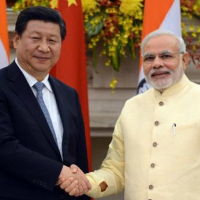Modi and Xi Sign Deals, But Border Dispute Remains Unresolved
 Xi and Modi shake hands in New Delhi (photo: AFP)
Xi and Modi shake hands in New Delhi (photo: AFP)
India and China have signed 12 agreements during Chinese President Xi Jinping’s maiden visit to New Delhi, including one which will see China investing $20 billion in India's infrastructure over the next five years. Yet the talks came as India accused China of fresh territorial incursions in Ladakh leading to a standoff between troops of both countries. At a joint news conference, Prime Minister Narendra Modi said "peace on the border" was important for mutual trust and progress.
Pitching for a quick clarification of the Line of Actual Control (LAC), the de facto border, Modi told Xi that China had to restore the status quo that existed before September 10.
"This is an important understanding, which should be strictly observed," Modi said as he raised "serious concerns" over what India calls serial transgressions by the Chinese.
The Chinese president responded by stating that he was committed to working with India to maintain "peace and tranquillity" on the border.
"China-India border issue is a problem which has troubled both sides for long... As the area is yet to be demarcated, there may be some incidents," Xi said in a media statement.
According to The Times of India, the standoff along the LAC continues in the Chumar sector in Eastern Ladakh, with both sides maintaining a distance of 200 meters from each other. India has sent additional troops to the area, while Chinese helicopters are dropping food packets to the 600 People's Liberation Army personnel in the area.
There have been reports in the Indian media of Chinese troops trying to construct a temporary road into Indian territory over the past week.
According to BBC News, the border dispute is an old one, dating back to 1914 when Britain, India's former colonial power, signed an agreement with Tibet making the McMahon Line the de-facto border between the two countries. China has rejected this border agreement.
Xi began his visit in Gujarat, Modi’s home state, on Wednesday, before heading to New Delhi. This is the first time that a Prime Minister had received a visiting leader in another state for talks. The two sides signed several agreements in Gujarat on Wednesday, including one to set up a Chinese-backed industrial park in the state.
Under the investment plans agreed in New Delhi, China pledged to help bring India's railway system railway system up-to-date with high-speed links and upgraded railway stations. China will also set up an industrial park in Maharashtra, and give more market access to Indian products, including pharmaceuticals and agricultural produce.
Trade between India and China is now worth almost $70 billion a year, although this is completely in China’s favour, with India's trade deficit with China rising to over $40 billion from just $1 billion in 2001-2002. This one-sided trading relationship is behind China’s newfound interest in investing in Indian infrastructure – the other reason being to counter Modi’s strong ties with Japanese Prime Minister Shinzo Abe.
Despite the efforts of both India and China to elevate their bilateral relationship during Xi’s visit, the past has intruded itself once again, with the ongoing border standoff reflecting “the suspicion and distrust that exist on both sides of the border,” according to BBC News.
To Learn More:
China's Xi Jinping signs landmark deals on India visit (BBC News)
Pull back your troops who have entered Ladakh, Modi tells Xi (by Sachin Parashar, The Times of India)
From $100bn to $20bn: What do the missing billions tell about India-China ties (by Pramit Pal Chaudhuri, Hindustan Times)
India is Open for Business, Modi Tells Japan (by Karan Singh, AllGov India)
- Top Stories
- Controversies
- Where is the Money Going?
- India and the World
- Appointments and Resignations
- Unusual News
- Latest News
- India College Chain’s Expansion into U.S. Draws Opposition from Massachusetts Officials over Quality of Education
- Milk Shortages in India Tied to Release of New Movies Featuring Nation’s Favorite Stars
- Confusion Swirls around Kashmir Newspaper Ban in Wake of Violent Street Protests
- Polio-Free for 5 Years, India Launches Vaccine Drive after Polio Strain Discovery
- New Aviation Policy Could Increase Service, Lower Ticket Prices






Comments